Timeline of typhoid fever
Jump to navigation
Jump to search
The content on this page is forked from the English Wikipedia page entitled "Timeline of typhoid fever". The original page still exists at Timeline of typhoid fever. The common ancestor The original content was released under the Creative Commons Attribution/Share-Alike License (CC-BY-SA), so this page inherits this license. This page has been edited significantly on the Timelines Wiki after forking and may differ significantly from the current version on Wikipedia.
This is a Timeline of typhoid fever, describing major events such as scientific/medical developments and notable epidemics.
Big Picture
| Year/period | Key developments |
|---|---|
| 1890s | Several different researchers work on the idea of protection against typhoid fever at the same time.[1] |
| 20th Century | Throughout the century, the incidence of typhoid fever steadily declines, due to the introduction of vaccinations and improvements in public sanitation and hygiene. In particular, the water chlorination would significantly reduce the incidence of typhoid fever among the population.[2] |
| 1970s–1980s | Antibiotics like fluoroquinolones such as ciprofloxacin and ofloxacin become widespread especially in countries where multidrug resistance is a problem.[3] |
| Recent years | According to the World Health Organization, there are about 22 million cases of typhoid fever and 200,000 deaths annually.[4][1][3] |
Full timeline
| Year/period | Type of event | Event | Geographical location |
|---|---|---|---|
| 460–377 BC | Scientific development | Greek physician Hippocrates describes clinical features resembling typhoid fever.[5] | Greece |
| 430–424 BC | Epidemic | Typhoid fever epidemic ravages Athens, whiping out about one third of its population.[6] | Greece |
| 1643 | Scientific development | English physician Thomas Willis describes typhoid fever in his Treatise on Fevers.[5][7] | United Kingdom |
| 1826 | Scientific development | French worker Pierre Bretonneau describes the constancy of intestinal lessions and attempts to clarify the pathology of typhoid fever.[5] | France |
| 1829 | Medical development | French physician Pierre Charles Alexander Louis becomes the first to use the word Thyphoide.[5] | |
| 1836 | Medical development | William Wood Gerhard differentiates typhus and typhoid as two distinct clinical entities and establishes the differential clinical and pathological features of both diseases.[5] | |
| 1838 | Medical development | English epidemiologist William Budd, while treating an outbreak of typhoid, notes that the poison (as he then calls it) is present in the excretions of the infected and could be transmitted to healthy people through contaminated water consumption. Upon realizing this association, Budd suggests isolating excrement to help control future outbreaks.[2][8] | United Kingdom |
| 1842 | Scientific development | John Goodsir describes differences in pathological lessons between typhus and typhoid fever.[5] | United Kingdom (Edinburgh) |
| 1861–1865 | Epidemic | About 80,000 soldiers die as a result of typhoid fever or dysentery in the American Civil War.[2] | United States |
| 1874 | Scientific development | Leydon links typhoid to symptoms in the nervous system. For some time typhoid fever would be described as brain fever and nervous fever.[5] | |
| 1880 | Scientific development | Kart Joseph Ebert first demonstrates the presence of bacterium salmonella typhi in the histologic sections of spleen and mesenteric glands of patients who had died of typhoid fever.[5][7] | |
| 1885 | Scientific development | German bacteriologists Richard Pfeiffer first discovers the presence of typhus–causing bacterium salmonella typhi in stools.[5] | Germany |
| 1886 | Scientific development | German bacteriologist Ferdinand Adolph Hueppe demonstrates the presence of typhus–causing bacterium salmonella typhi in urine.[5] | |
| 1894 | Scientific development | Austrian pathologist Hans Chiari successfully cultures typhoid bacillus in gallblader.[5] | |
| 1896 | Scientific development | German bacteriologists Richard Pfeiffer and Wilhelm Kolle demonstrate that inoculation with killed typhoid bacteria results in human immunity against typhoid fever.[1] | Germany |
| 1896 | Scientific development | French physicians Émile Achard and Raoul Bensaude isolate bacterium salmonella paratyphi B and are the first to use the term paratyphoid fever.[5] | France |
| 1896 | Scientific development | George Widal develops a typhoid fever diagnostic using the serum of patients who are recovering from the disease.[7][5] | |
| 1896 | Medical development | British bacteriologist Almroth Wright develops the first effective vaccine for typhoid, an inactivated vaccine[9], which is introduced for military use.[10] | United Kingdom |
| 1897 | Medical development | British bacteriologist Almroth Wright develops a vaccine prepared from killed typhoid bacilli as a preventive of typhoid.[1] | United Kingdom |
| 1897–1898 | Epidemic | Typhoid fever epidemic breaks out in Maidstone, England, involving 2,000 people and claiming 143 lives.[11] | United Kingdom |
| 1899–1902 | Epidemic | Second Boer War. Typhoid fever is estimated to be the cause of twice as many deaths as from weapons.[5] In an outbreak in 1900 in Bloemfontein, 5,000 cases and 143 deaths are calculated.[11] | South Africa |
| 1904 | Bacteriologists in the United States Army propose to administer killed typhoid bacilli as an oral vaccine against typhoid fever. The bacterial culture is intended to be inactivated by heating at 56°C for one hour. Initial cultures of the heated vaccine are sterile. Of 13 men who ingested the vaccine, 7 develop clinical typhoid fever and 3 others suffer "febrile illness".[12] | United States | |
| 1906 | Epidemic | Typhoid fever epidemic breaks out in Philadelphia, Pennsylvania, involving 9,712 people and claiming 63 lives.[11] | United States |
| 1907–1915 | Infection | Irish immigrant Mary Mallon (better known as Typhoid Mary) becomes the first person in the United States identified as an asymptomatic carrier of the pathogen associated with typhoid fever. Presumed to have infected 51 people (three of whom die), Mary Mallon would be forcibly isolated for quarantine purposes twice in her life, once in 1907 and again in 1915. The second time she would not be released, dying in isolation at the age of 69.[2][13][7] | United States |
| 1909 | Medical development | United States Army physcian Frederick F. Russell develops a perfected typhoid fever vaccine, and the first in the United States. Russell would begin immunizing volunteers in the army, and after demonstrating its effectiveness, the army would make would make typhoid immunization compulsory, reducing the rate from 243 to 4.41 in three years.[14][1][15] | United States |
| 1914 | Campaign | Typhoid vaccination moves beyond military forces and are released for the general public.[1] | United States |
| 1914 | Medical development | The heat-inactivated phenol-preserved typhoid vaccine is licensed in the United States. It would be later presumed that the routine use of typhoid vaccine contributed troops of the US Army to have the lowest reported incidence of typhoid fever among the various nations whose armies were major combatants in World War I.[16] | United States |
| 1927 | Epidemic | Typhoid fever epidemic breaks out in Montreal. 5,353 cases and 538 deaths are recorded. Milk is found to be the source of the outbreak.[11] | Canada |
| 1948 | Medical development | American medical researcher Theodore Woodward and colleagues publish the first report on the use of Chloramphenicol for the treatment of typhoid fever. Chloroamphenicol would revolutionize the field by reducing both morbidity and mortality.[3][17][7][5] | |
| 1953 | Scientific development | Antibacterial agent furazolidone is reported effective in vitro for treating common species of salmonella. The drug would later be used for the treatment against typhoid fever.[18][5] | |
| 1961 | Medical development | Ampicillin is introduced for the treatment against typhoid fever.[19][5] | |
| 1963 | Epidemic | Typhoid fever outbreak is reported at a ski resort in Zermatt, Switzerland, affecting tourists from across Europe and the United States. 437 cases and 3 deaths are reported.[11] | Switzerland |
| 1969 | Medical development | Antibiotic agent Trimethoprim/sulfamethoxazole (also known as co-trimoxazole) is introduced. The drug would prove to be effective in the treatment against typhoid fever.[20][5] | |
| 1972 | Medical development | Researchers from Beecham Group develop antibiotic amoxicillin. It would prove to be very effective against typhoid fever, reducing the risk of the carrier state. Amoxicilin is on the World Health Organization's List of Essential Medicines.[5][21] | |
| 1972–1973 | Epidemic | Typhoid fever epidemic breaks out in Mexico City. 2,343 cases and 39 deaths are reported.[11] | Mexico |
| 1975 | Medical development | Live attenuated Ty21a is introduced as an oral typhoid vaccine, developed through the chemical mutagenesis of pathogenic Salmonella enterica serovar Typhi strain Ty2. This vaccine would be used for many years to combat typhoid fever.[22][23] | |
| 1975–1976 | Epidemic | Typhoid fever epidemic breaks out in Maharashtra, involving 9,000 cases. Contamination of a municipal water suply is found to be the source of the outbreak.[11] | India |
| 1983 | Outbreak | 58 cases of typhoid fever are reported among tourists at a hotel in Greece.[11] | Greece |
| 1983 | Medical development | Oral live attenuated TY21a is first licensed in Europe.[24] | Europe |
| 1986 | Medical development | Researchers at the United States National Institutes of Health develop an injectable subunit vaccine Vi-polysaccharide vaccine (sold as Typhim Vi by Sanofi Pasteur and Typherix by GlaxoSmithKline), for immunization against typhoid fever.[3] | United States |
| 1990-1993 | Epidemic | Typhoid fever epidemic breaks out in South Vietnam. A total per year of 3,853 to 9,179 cases is registered, and from 8 to 31 deceases.[25] | Vietnam |
| 1993 | Epidemic | Typhoid fever epidemic breaks out in Mpumalanga, South Africa. Contamination of water supplies is associated. 2,129 cases are reported.[26][11] | South Africa |
| 1996-1997 | Epidemic | Multidrug-resistant typhoid fever epidemic breaks out in Tajikistan. Between 8,000 and 17,000 cases and 150 deaths are estimated. Municipal water is identified as the source.[11][27] | Tajikistan |
| 2001 | Epidemic | Typhoid fever epidemic breaks out in vaccinated members of the French Armed Forces in Ivory Coast.[28] | Ivory Coast |
| 2002 | Epidemic | Typhoid fever epidemic breaks out in Bharatpur, Nepal. 65% of the town population is involved. 5,963 and 4 deaths are reported.[11] | Nepal |
| 2003 | Epidemic | Typhoid fever epidemic breaks out in Dushanbe, Tajikistan. 1,000 cases and 80 deaths are reported.[11] | Tajikistan |
| 2004-2005 | Epidemic | Typhoid fever epidemic breaks out in Kinshasa. 11 cases of typhoidal peritonitis are treated in a single hospital. A total of 42,564 infections (including 696 intestinal perforations) and 214 deaths are reported.[11] | Democratic Republic of the Congo |
| 2006 | Epidemic | Typhoid fever epidemic breaks out in Southern Highlands Province, Papua New Guinea. 1,200 cases and 6 death are reported.[11] | Papua New Guinea |
| 2007 | Medical development | Live attenuated vaccine (DV-STM-07) is developed for immunization against typhoid fever.[3] | |
| 2008 | Epidemic | Typhoid fever epidemic breaks out in Calamba City, Philippines. 1,477 cases are reported.[11] | Philippines |
| 2010 | Outbreak | 12 cases of typhoid are reported in the United States. The outbreak is ascribed to ingestion of contaminated mamey fruit pulp imported from Guatemala.[11] | United States |
| 2011-2012 | Epidemic | Typhoid fever epidemic breaks out in Zambia. 4,396 cases and 9 deaths are reported.[11] | Zambia |
| 2011-2013 | Epidemic | Typhoid fever epidemic breaks out in Zimbabwe. 4,185 cases are confirmed in Harare and 2,094 in Mupambe Township. Contaminated water sources are associated. As of 2017, the epidemic is still ongoing.[26][11] | Zimbabwe |
| 2013 | Epidemic | Typhoid fever epidemic breaks out in Kasai-Occidental, D.R. Congo. 1,092 cases are reported.[11] | Democratic Republic of the Congo |
| 2014-2015 | Outbreak | 18 cases of salmonella paratyphi A infection are reported among Japanese travellers returning from Cambodia.[11] | Cambodia, Japan |
| 2015 | Epidemic | Large typhoid fever epidemic breaks out in Kampala, Wakiso and Mukono districts in Uganda. 12,000 cases are reported.[11] | Uganda |
Numerical and visual data
Google Scholar
The following table summarizes per-year mentions on Google Scholar as of November 6, 2021.
| Year | "typhoid fever" |
|---|---|
| 1900 | 1,160 |
| 1910 | 1,010 |
| 1920 | 753 |
| 1930 | 595 |
| 1940 | 517 |
| 1950 | 868 |
| 1960 | 426 |
| 1970 | 719 |
| 1980 | 688 |
| 1990 | 954 |
| 2000 | 1,820 |
| 2010 | 3,550 |
| 2020 | 5,680 |
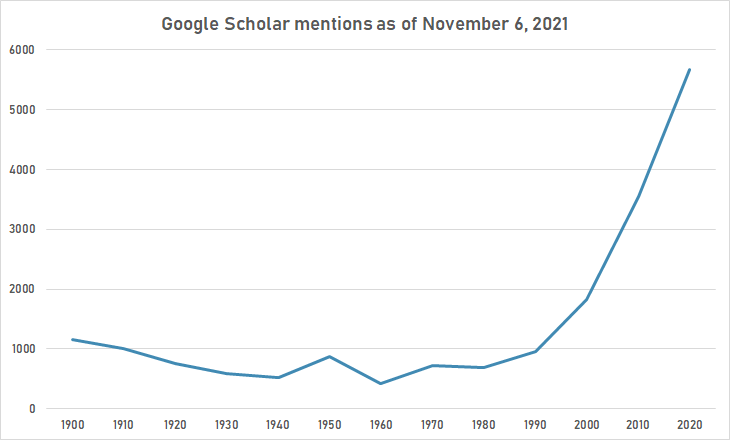
Google Trends
The chart below shows Google Trends data for Typhoid fever (Disease), from January 2004 to April 2021, when the screenshot was taken. Interest is also ranked by country and displayed on world map.[29]
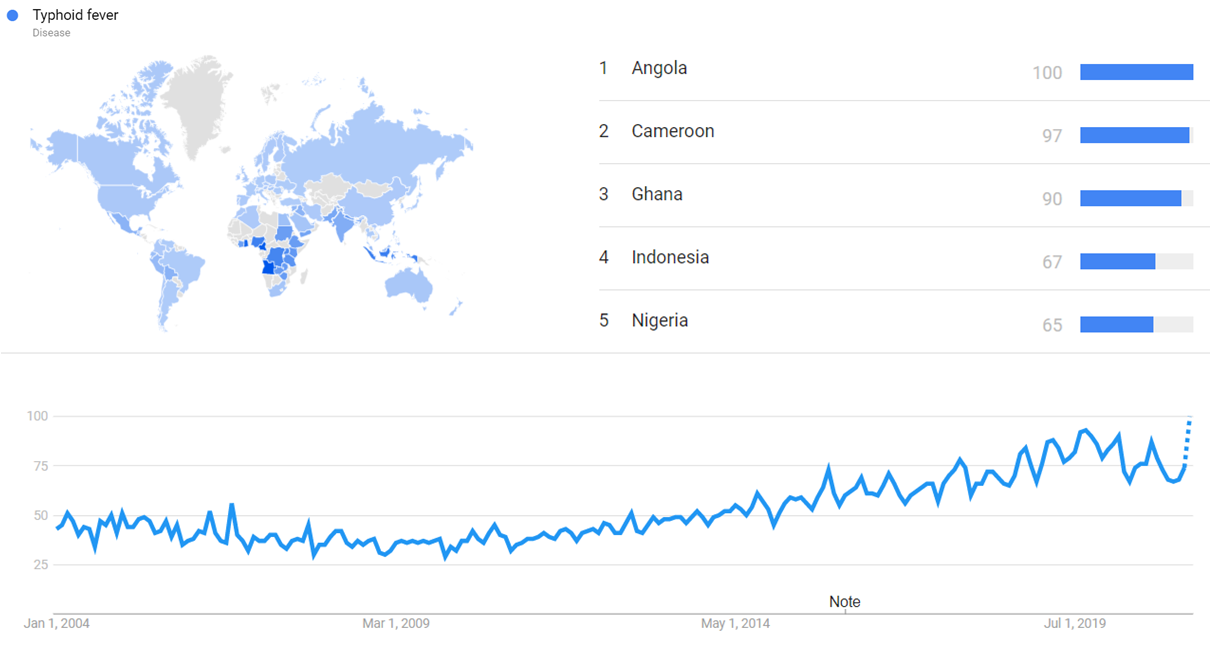
Google Ngram Viewer
The chart below shows Google Ngram Viewer data for Typhoid fever, from 1800 to 2019.[30]
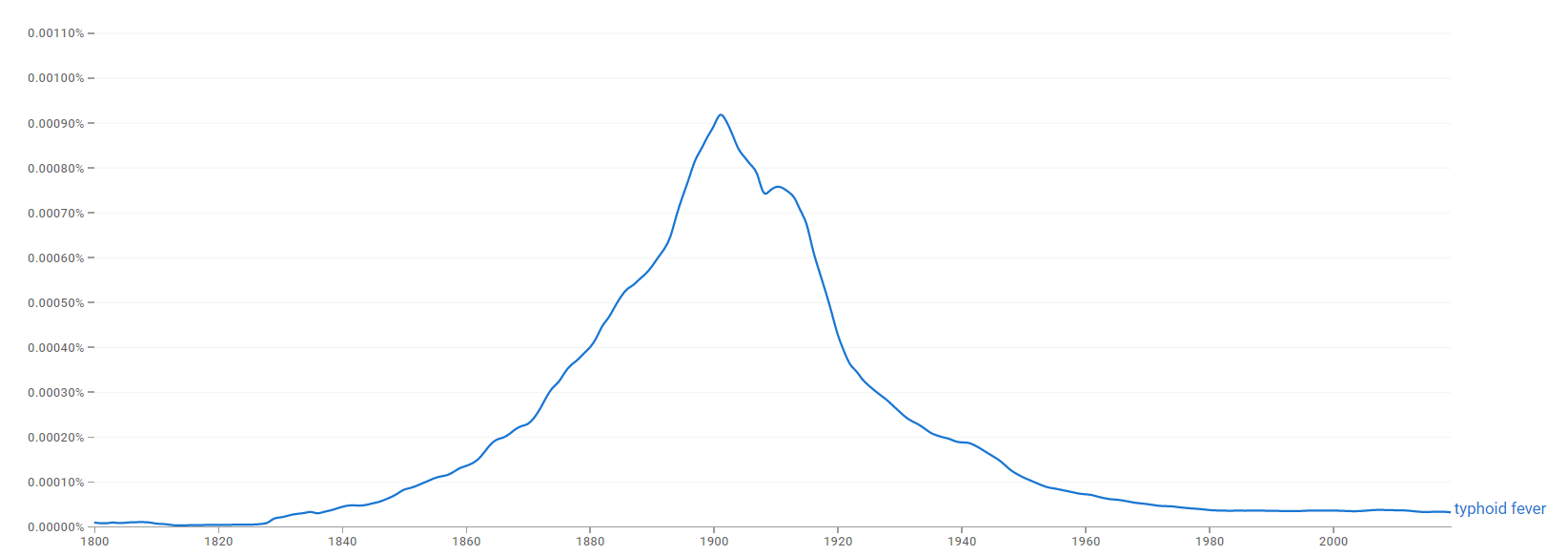
Wikipedia Views
The chart below shows pageviews of the English Wikipedia article Typhoid fever, from July 2015 to March 2021.[31]
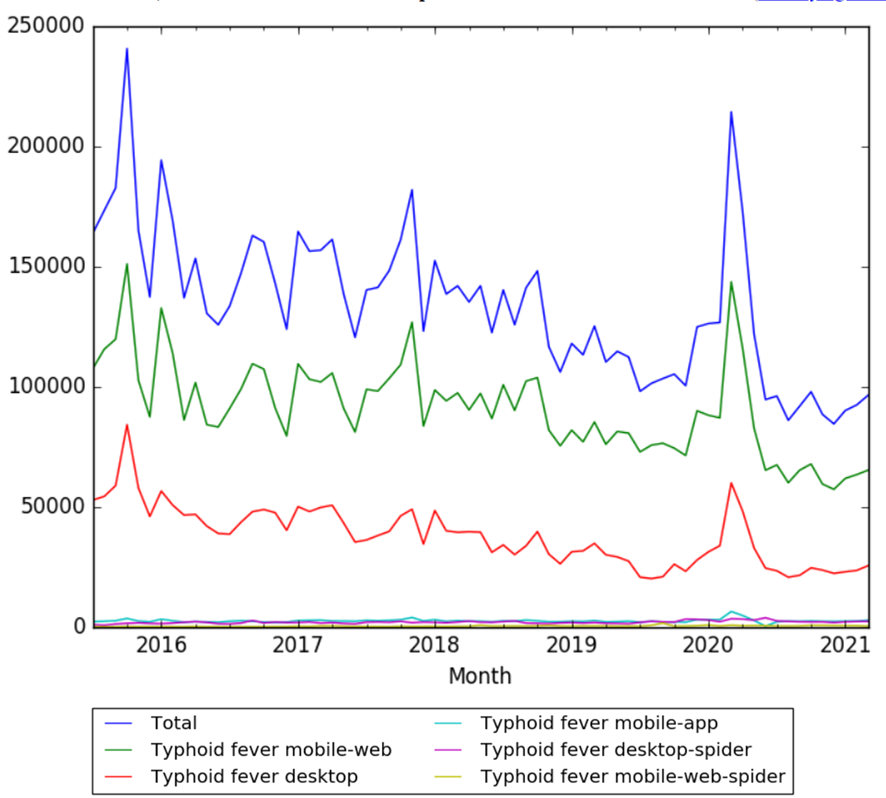
Other
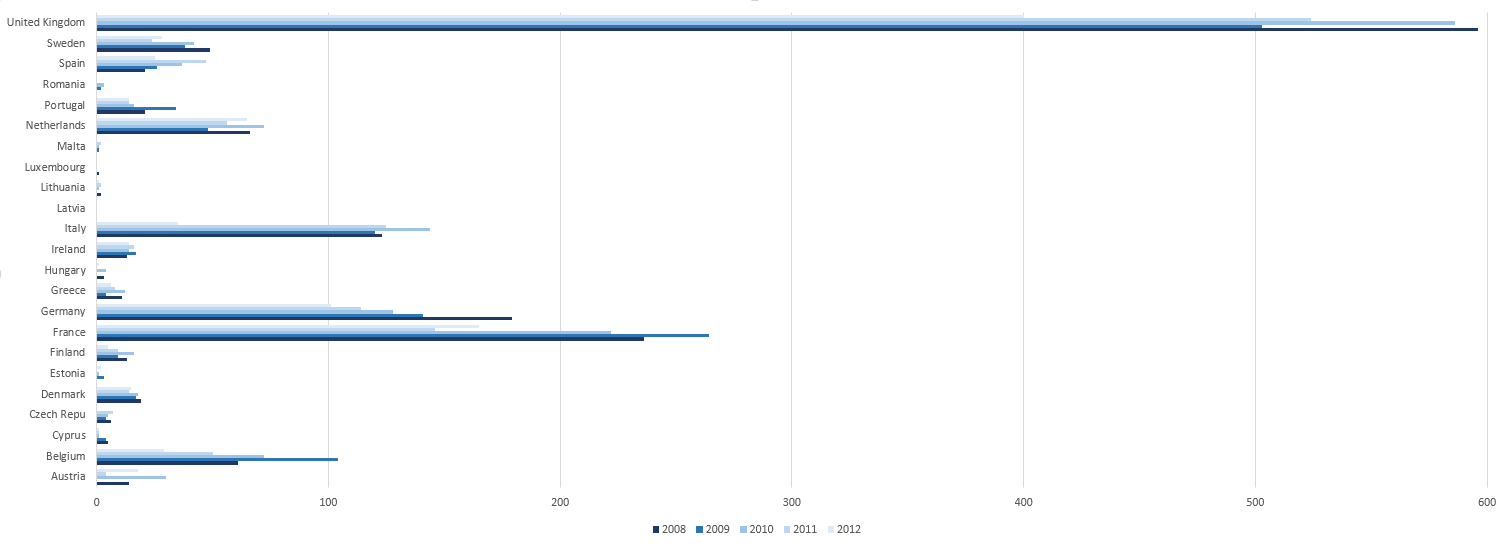
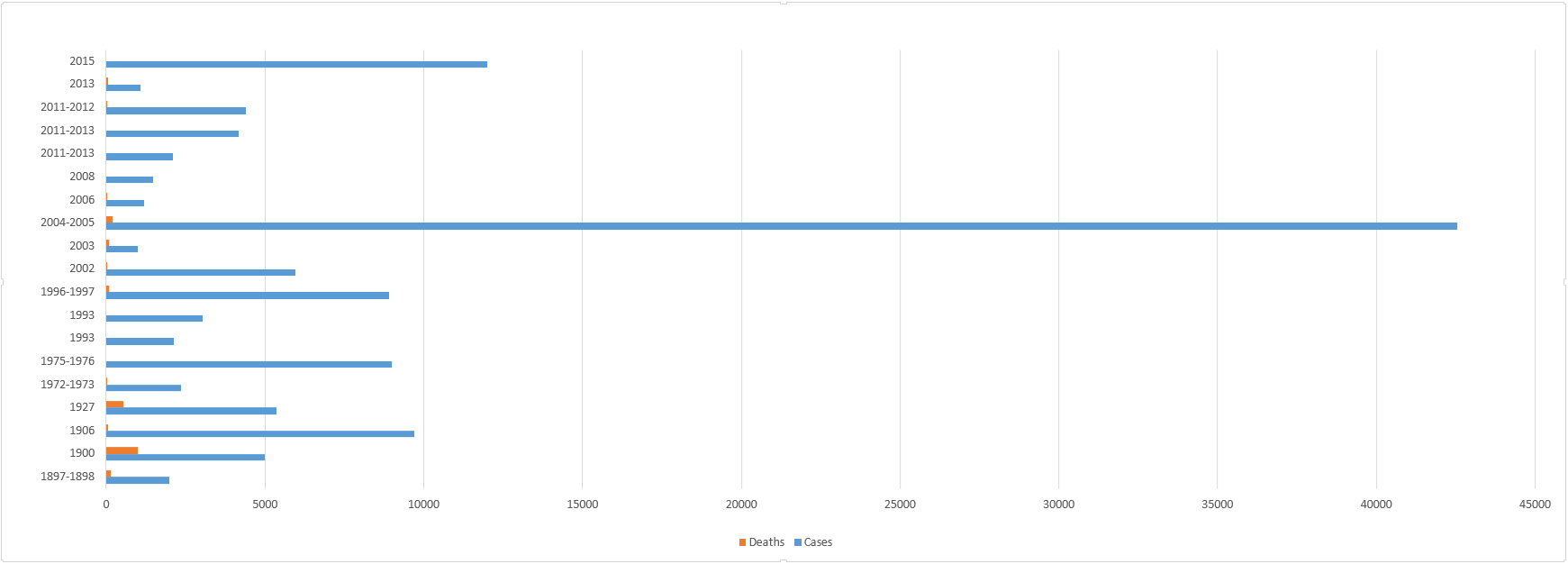
See also
References
- ↑ 1.0 1.1 1.2 1.3 1.4 1.5 "Typhoid Fever Symptoms and Causative Agent". historyofvaccines.org. Retrieved 10 February 2017.
- ↑ 2.0 2.1 2.2 2.3 "Typhoid Fever History". news-medical.net. Retrieved 11 February 2017.
- ↑ 3.0 3.1 3.2 3.3 3.4 Marathe, Sandhya A.; Lahiri, Amit; Devi Negi, Vidya; Chakravortty, Dipshikha. "Typhoid fever & vaccine development: a partially answered question". PMC 3336846.
{{cite journal}}: Cite journal requires|journal=(help) - ↑ "Typhoid Fever Quick Overview". emedicinehealth.com. Retrieved 10 February 2017.
- ↑ 5.00 5.01 5.02 5.03 5.04 5.05 5.06 5.07 5.08 5.09 5.10 5.11 5.12 5.13 5.14 5.15 5.16 5.17 5.18 Khosla, S.N. Typhoid FeverIts Cause, Transmission And Prevention. Retrieved 3 March 2017.
- ↑ "Top 10 epidemic diseases that were common in ancient world". ancienthistorylists.com. Retrieved 3 March 2017.
- ↑ 7.0 7.1 7.2 7.3 7.4 Emmeluth, Donald; Alcamo, Edward. Typhoid Fever. Retrieved 3 March 2017.
- ↑ Moorhead, Robert. "William Budd and typhoid fever". PMC 1279260.
{{cite journal}}: Cite journal requires|journal=(help) - ↑ Plotkin, S. (2014-08-26). "History of vaccination". Proceedings of the National Academy of Sciences. 111 (34): 12283–12287. doi:10.1073/pnas.1400472111.
- ↑ Riley, James C. Low Income, Social Growth, and Good Health: A History of Twelve Countries.
- ↑ 11.00 11.01 11.02 11.03 11.04 11.05 11.06 11.07 11.08 11.09 11.10 11.11 11.12 11.13 11.14 11.15 11.16 11.17 11.18 11.19 11.20 11.21 Berger, Stephen. Typhoid and Enteric Fever: Global Status: 2017 edition. Retrieved 4 March 2017.
- ↑ New generation vaccines (3rd, rev. and expanded ed.). New York: Marcel Dekker. 2004. ISBN 9780203014158.
- ↑ "'TYPHOID MARY' DIES OF A STROKE AT 68; Carrier of Disease, Blamed for 51 Cases and 3 Deaths, but She Was Held Immune Services This Morning Epidemic Is Traced". archive.org. Retrieved 11 February 2017.
- ↑ Byerly, Carol R. Fever of War: The Influenza Epidemic in the U.S. Army during World War I. Retrieved 4 March 2017.
- ↑ Cirillo, Vincent J. Bullets and Bacilli: The Spanish-American War and Military Medicine. Retrieved 4 March 2017.
- ↑ Plotkin, Stanley A. (21 September 2006). Mass Vaccination: Global Aspects - Progress and Obstacles. Springer Science & Business Media. ISBN 978-3-540-36583-9.
- ↑ Bitar, R; Tarpley, J. "Intestinal perforation in typhoid fever: a historical and state-of-the-art review". PMID 3890098.
{{cite journal}}: Cite journal requires|journal=(help) - ↑ Bierer, Bert W.; Vickers, C. L. "Nitrofuran Medication for Experimental Salmonella typhimurium Infection in Poults". Avian Diseases. doi:10.2307/1587464. JSTOR 1587464.
- ↑ Simon, Harold J.; Miller, Raymond C. "Ampicillin in the Treatment of Chronic Typhoid Carriers — Report on Fifteen Treated Cases and a Review of the Literature". doi:10.1056/NEJM196604142741501. Retrieved 3 March 2017.
{{cite journal}}: Cite journal requires|journal=(help) - ↑ LACEY, R. W. "DO SULPHONAMIDE-TRIMETHOPRIM COMBINATIONS SELECT LESS RESISTANCE TO TRIMETHOPRIM THAN THE USE OF TRIMETHOPRIM ALONE?" (PDF). The Journal of Medical Microbiology. Retrieved 3 March 2017.
- ↑ "Amoxicillin". emedexpert.com. Retrieved 3 March 2017.
- ↑ Pennington, Shaun Harry. "The human immune response to oral vaccination with liveattenuated Salmonella Typhi (Ty21a)". livrepository.liverpool.ac.uk.
{{cite web}}:|access-date=requires|url=(help); Missing or empty|url=(help) - ↑ "Ty21a - an overview | ScienceDirect Topics". www.sciencedirect.com. Retrieved 7 February 2021.
- ↑ Amicizia, D; Arata, L; Zangrillo, F; Panatto, D; Gasparini, R (March 2017). "Overview of the impact of Typhoid and Paratyphoid fever. Utility of Ty21a vaccine (Vivotif®)". Journal of preventive medicine and hygiene. 58 (1): E1 – E8. PMID 28515625.
- ↑ Nguyen, TA; Ha, Ba K; Nguyen, TD. "[Typhoid fever in South Vietnam, 1990-1993]". PMID 7819805. Retrieved 5 April 2017.
{{cite journal}}: Cite journal requires|journal=(help) - ↑ 26.0 26.1 "Typhoid -caused by Salmonella Typhi-Frequently Asked Questions". South African National Institute for Communicable Diseases. Retrieved 4 March 2017.
- ↑ "Salmonella typhi (Typhoid Fever) and S. paratyphi (Paratyphoid Fever)". antimicrobe.org. Retrieved 4 March 2017.
- ↑ Michel, Rémy; Garnotel, Eric; Spiegel, André; Morillon, Marc; Saliou, Pierre; Boutin, Jean-Paul. "Outbreak of Typhoid Fever in Vaccinated Members of the French Armed Forces in the Ivory Coast". European Journal of Epidemiology.
- ↑ "Typhoid fever". Google Trends. Retrieved 27 April 2021.
- ↑ "Typhoid fever". books.google.com. Retrieved 27 April 2021.
- ↑ "Typhoid fever". wikipediaviews.org. Retrieved 27 April 2021.
- ↑ "Annual epidemiological report 2014" (PDF). europa.eu. Retrieved 4 March 2017.